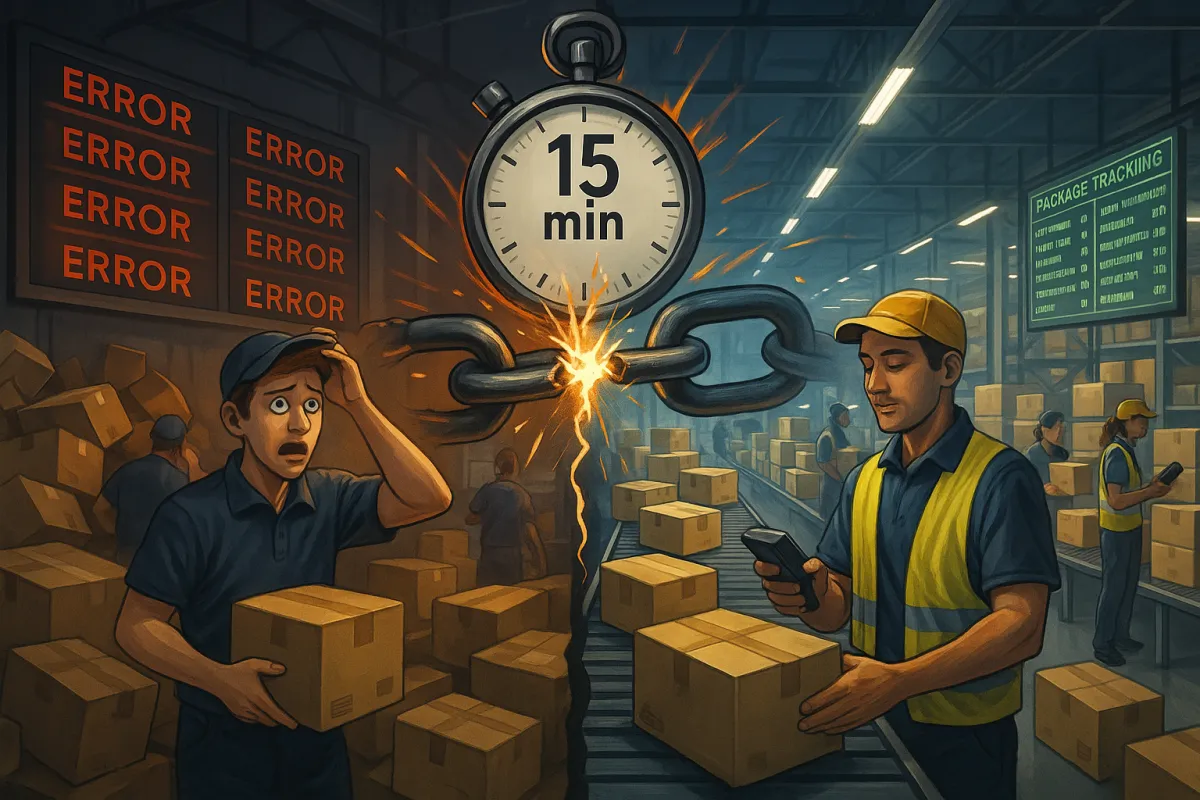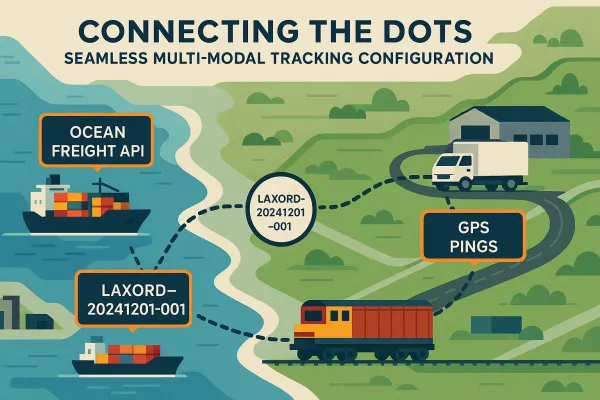TMS Webhook Failures: The 15-Minute Triage That Prevents Label Disasters

Your shipping labels failed. Again. The tracking dashboard shows gaps. Customers are calling about missing packages. You just discovered your TMS webhook failures after they've been silently breaking your integrations for three days.
Delays in data processing that are caused by webhook failures can have an impact on users. This can cause your data to become out of sync, especially if you process a lot of webhook events or time-sensitive data. Most teams treat webhook monitoring as an afterthought until their operations grind to a halt.
The reality? TMS webhook failures are your silent killer. They break label generation, disconnect tracking updates, and create data sync issues that compound every hour you don't catch them. Shopify retries failed webhook calls up to eight times in a four-hour period, but if failures persist past that point the webhook subscription is removed. When your webhook subscriptions start disappearing, you're looking at manual label creation and tracking updates until you can rebuild the connections.
Why Webhook Failures Are Your Silent TMS Killer
Unlike carrier API timeouts that throw immediate errors, webhook failures happen quietly in the background. Your TMS sends shipping events to external systems. Label status updates to your warehouse management system. Tracking notifications to customer service platforms. The delivery logs dashboard doesn't provide real-time updates. Data could be delayed up to several minutes.
Three failure scenarios crush operations teams:
The Cascade Effect: A single webhook endpoint goes down. Within hours, you have thousands of failed deliveries backing up. Order status updates stop flowing. Customer service starts fielding calls about packages that show "label created" but never move.
The Silent Degradation: Webhook deliveries slow down but don't fail completely. Processing delays build up. Your TMS shows everything working, but your fulfillment center falls behind because status updates arrive 30 minutes late.
The Authentication Trap: Webhook authentication expires. New attempts fail with 401 errors. Your TMS keeps sending requests to dead endpoints while your operations team wonders why shipment data stopped synchronizing with their ERP system.
Compare how different platforms handle webhook monitoring. ShipStation provides basic retry mechanisms but limited visibility into failure patterns. Cargoson offers comprehensive webhook management alongside competitors like MercuryGate and Manhattan Active. Each platform has different timeout tolerances and retry strategies you need to understand.
The Anatomy of TMS Webhook Breakdowns
Five failure patterns cause 90% of webhook disasters. Even when you offload all the processing to another thread you will still have a timeout if your function (google cloud functions / aws lambda) has a cold start. Cold starts will always induce a timeout.
Pattern 1: Connection Timeouts (30+ seconds)
Your webhook endpoint takes too long to respond. Webhooks posting to your endpoint will timeout after 10 seconds. But timeout values vary wildly by platform. There's a 1 second timeout? 1 second is pretty low. HubSpot's aggressive 1-second timeout catches many integrations off guard.
Pattern 2: HTTP 4XX Errors (Client Side)
Authentication failures, malformed requests, or missing endpoints. We'll automatically retry in the case of a timeout (the only case we won't retry is when we did get a response but with a status code of 400, 401, 403, 404, or 405). No retry means these failures require immediate attention.
Pattern 3: HTTP 5XX Errors (Server Side)
Your endpoint returns server errors. Stripe attempts to deliver events to your destination for up to three days with an exponential back off in live mode. Platforms handle retries differently. Some give up after hours, others persist for days.
Pattern 4: Exponential Backoff Overload
Each time that a delivery fails, the time between retried deliveries increases. Your system recovers, but the platform is still in backoff mode. Webhook deliveries trickle in over hours instead of arriving in real-time.
Pattern 5: Carrier API Cascade Failures
FedEx API goes down. Your webhook tries to fetch updated tracking data and fails. Instead of queuing the webhook for retry, your TMS marks it as processed. Read timeout or fundamental problems which require interference (00004 - certificate error). Hours later, you discover missing tracking updates with no automatic recovery path.
The 15-Minute Emergency Triage Checklist
When webhook failures hit production, you have 15 minutes to assess damage and implement temporary fixes before operations teams start manual workarounds.
Rapid Health Check Protocol (Minutes 1-5)
Start with your webhook monitoring dashboard. Look for these red flags:
- Delivery success rate below 95% over the last hour
- Response times above your platform's timeout threshold
- Error rate spikes in specific webhook topics (shipping.label_created, tracking.updated)
- Retry queue backlog exceeding normal volumes by 3x
Check your endpoint status pages first. Run a quick curl test against your webhook endpoints:
curl -X POST https://your-webhook-endpoint.com/shipping/status -H "Content-Type: application/json" -d '{"test": true}' -w "%{time_total}"
Response time above 2 seconds? You've found your bottleneck. In general, if your process takes more than a second, we'd recommend accepting the data from the webhook request, and then placing that data into a queue that could be processed asynchronously from the webhooks.
Root Cause Analysis (Minutes 6-10)
Dig into your webhook delivery logs. Most platforms provide failure breakdowns by error code:
Timeout patterns indicate infrastructure problems. I have a highly available simple API endpoint for my integration that does nothing else but queueing the webhooks processing tasks. From there, my main application is polling the queue and it can take any time to write the data into the database. If you see consistent timeouts, your webhook processing is too complex.
Authentication errors (401, 403) mean your webhook secrets expired or your endpoint security changed. Check your API key rotation schedule.
Server errors (5XX) from your side indicate application problems. Scale up your webhook processing servers or implement circuit breakers to prevent cascade failures.
Immediate Mitigation (Minutes 11-15)
Temporary fixes to stop the bleeding:
Manual Retry Trigger: In the Stripe Dashboard, click Resend when looking at a specific event. This works for up to 15 days after the event creation. Most TMS platforms offer manual webhook replay functionality.
Endpoint Scaling: Spin up additional webhook processing capacity. Add load balancer endpoints if your infrastructure supports it.
Queue Implementation: Implement a simple webhook queue to handle the backlog. Accept webhook payloads quickly, process asynchronously.
Stakeholder Communication: Alert operations teams about potential delays. Provide manual backup procedures for label printing and tracking updates.
Escalate to carriers when you see patterns like "UPS server is temporary not able to communicate rates" or authentication errors that suggest problems on their end.
Building a Webhook Monitoring System That Actually Works
Reactive troubleshooting wastes hours every week. Build monitoring that catches failures before they impact operations.
Your monitoring stack needs four components:
Real-time Success Rate Tracking
Monitor webhook delivery success rates every 5 minutes. Alert when success rate drops below 98% for any webhook topic. Track by endpoint, carrier, and event type. Your TMS dashboard should show which integration broke, not just that something failed.
Response Time Monitoring
Quickly returns a successful status code (2xx) prior to any complex logic that might cause a timeout. For example, you must return a 200 response before updating a customer's invoice as paid in your accounting system. Monitor webhook endpoint response times. Alert when average response time exceeds 50% of your timeout threshold.
Retry Pattern Analysis
For best results, write webhook batches to disk and then process asynchronously to minimize data loss if you have a problem with your database. Webhook batch status is available for 24 hours via the UI or the API. Track retry patterns to identify systemic issues. Exponential backoff should resolve temporary problems within minutes, not hours.
Queue Depth Monitoring
Monitor webhook processing queue depth. Alert when queue grows beyond 5-minute processing capacity. Implement auto-scaling triggers for webhook processing infrastructure.
Popular monitoring solutions work differently across TMS platforms. Cargoson provides built-in webhook monitoring alongside competitors like Descartes, Oracle TM, and nShift. Each offers different visibility into failure patterns and retry logic.
Post-Incident Playbook: What to Document and Fix
Every webhook failure teaches you something about your system's weak points. Document lessons learned to prevent repeat failures.
Your post-incident template should capture:
Failure Timeline: When did the first webhook fail? When did you discover the problem? How long until mitigation? Track your mean time to detection (MTTD) and mean time to recovery (MTTR).
Impact Scope: Which webhook endpoints failed? How many events were lost or delayed? Which business processes were affected? Quantify the operational impact in hours of manual work or lost productivity.
Root Cause Analysis: Infrastructure problem, application bug, or third-party dependency failure? Be specific. "Database timeout" isn't useful. "Database connection pool exhausted under 500 concurrent webhook requests" gives you something to fix.
Prevention Measures: What configuration changes, monitoring improvements, or process updates prevent recurrence? Implement these within 48 hours while the incident is fresh.
Update your webhook failure runbooks after every incident. Your 3 AM operations team needs step-by-step procedures, not general troubleshooting advice.
Advanced: Webhook Resilience Patterns for High-Volume Operations
Enterprise shipping operations need webhook architectures that handle thousands of events per minute without breaking.
Circuit Breaker Implementation
When webhook failure rates exceed thresholds, temporarily stop sending requests to failing endpoints. Implement graceful degradation where shipping operations continue with reduced visibility rather than complete failure.
Queue Management Strategy
Separate webhook queues by priority and event type. Label creation webhooks get higher priority than tracking update webhooks. Implement dead letter queues for events that fail after maximum retries.
Failover Architecture
Configure multiple webhook endpoints for critical integrations. When primary endpoint fails, automatically route events to backup endpoints. Test failover procedures monthly, not during outages.
Different TMS vendors handle enterprise webhook requirements differently. Blue Yonder and SAP TM offer robust webhook management features. E2open provides flexible retry configuration. Cargoson delivers enterprise-grade webhook reliability alongside these established players. Evaluate webhook architecture capabilities during TMS selection, not after implementation.
Start with the 15-minute triage checklist. Build monitoring that alerts before failures impact operations. Document every incident to prevent recurrence. Your webhook infrastructure should be invisible to operations teams, not a source of daily firefighting.





